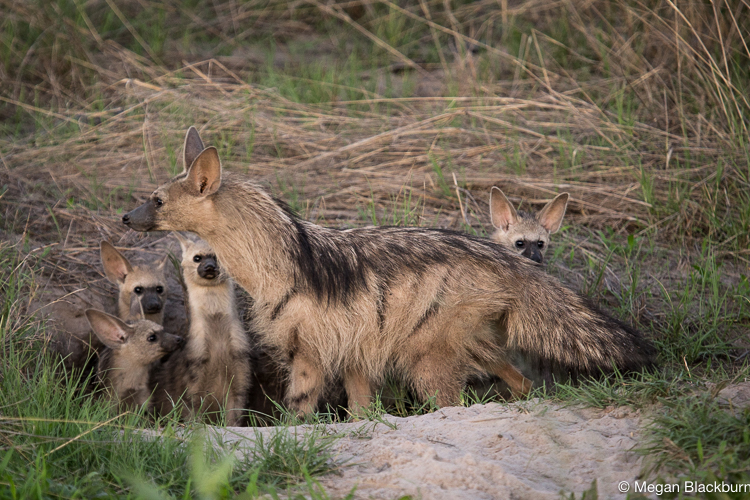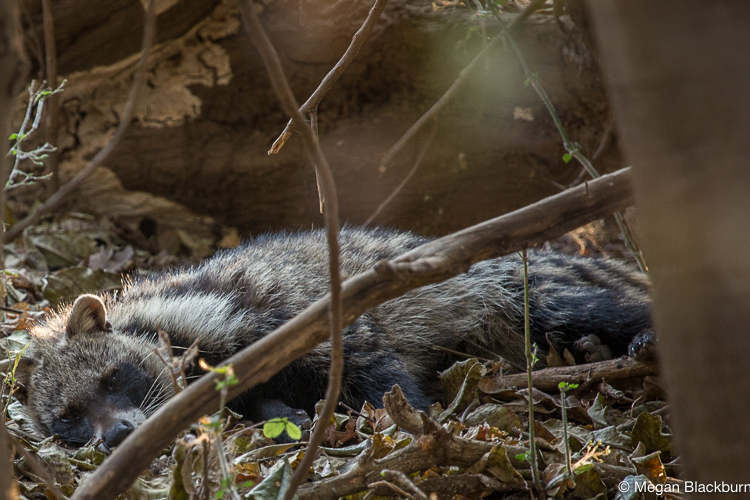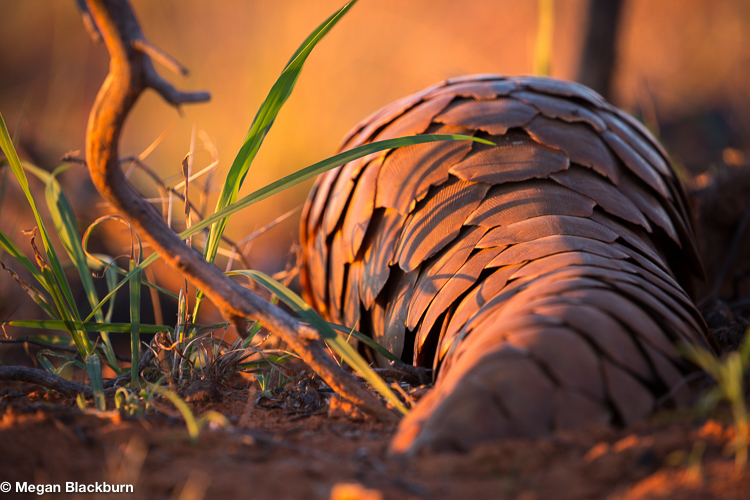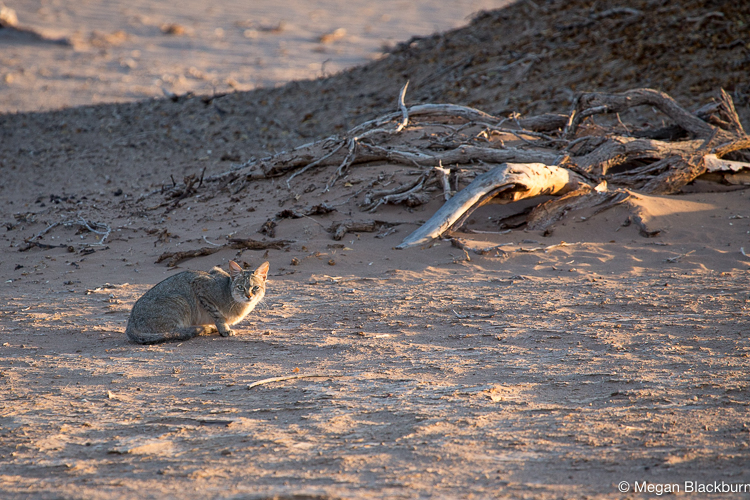
Elusive Eleven
Everyone has heard about the Big Five, but what about the elusive eleven? Here is a look at the bush’s secretive, primarily nocturnal creatures. I have seen eight, but have only photographed four. I suppose I will have to schedule another safari!
Aardvark
I caught a fleeting glimpse of an aardvark running away from the safari vehicle at Tswalu Kalahari in South Africa. We followed the aardvark for a bit before he dove down a burrow, although it must not have been one of his usual haunts because when we peered down the hole his tail was visible. The translation from Afrikaans to English is earth pig, an apt description of this unmistakable creature. Aardvarks are covered by coarse hair with their skin exposed underneath. They largely subsist on termites and ants which they trap on their long sticky tongue. Being primarily nocturnal, we were lucky to see on foraging during the day. Tswalu is considered one of the best places in South Africa to see these odd looking animals and during June and July tracking them on foot is common.
Aardwolf
One of the most unique sightings I have had was of aardwolves at Sandibe in the Okavango Delta, Botswana. I had never heard of an aardwolf prior to seeing one, but I knew how special the sighting was based on the reaction of the South African guests who could not stop commenting how rare this was. The aardwolf was denning with her four cubs and despite being the height of summer, these nocturnal animals were active around the den. These mammals are part of the same family as hyenas, but have a vastly different diet. They almost exclusively eat termites and may eat 300,000 termites a night.
African Civet
I still am not sure how the tracker spotted the civet curled up and sleeping under a tree at Sausage Tree camp in the Lower Zambezi National Park. Civets are in the same family of genets. They are dependent on water as they cannot go for long periods without drinking and are often found in dense woodlands with surface water. These animals are not picky eaters. They nibble on everything from rodents, to lizards, birds, and even insects.
Bushpig
It would be easy to mistake a bushpig for a warthog, but if you look closely, you will see that they are covered in coarse hair, are more reddish in color, and have smaller tusks. I saw a bush pig family, or sounder, one evening when returning back to camp at Phinda Private Game Reserve. These omnivorous pigs primarily eat fruit, although they will root for tubers and larvae.
Caracal
I have yet to see a caracal and of all the elusive eleven I have yet to see, this is the one I would be most excited to come across. These small cats have large black tufts at the end of their ears and their sleek bodies make them one of the most beautiful cats. Their diet consists mainly of small antelope, dassies, and hares and like all of the animals on this list are primarily nocturnal.
Honey Badger
Honey badgers are clever and have a reputation for ferocity when threatened. They are so ferocious that young cheetah cubs mimic the coloring of a honey badger with a black underbelly and white grey stripe from the top of the head to the tip of the tail. They are incredible diggers and in soft, sandy ground they can dig and submerge themselves completely underground in two minutes. They dig to find prey, including mice, snakes, lizards, and upon occasion larger mammals, but they can become a nuisance at camp sights or lodges where they have been known to stage raids and scavenge for food.
Pangolin
“Pangolin,” our tracker shouted. He spotted the tracks in the sand crossing the road and those tracks led us to the pangolin on the side of the road. Pangolin were the entire reason I had returned to Tswalu. These secretive creatures look like mini-dinosaurs, especially since they walk on their hind legs. Despite looking like a lizard, pangolins are actually scale-covered mammals. The holy grail of wildlife sightings has to be a pangolin with a young pangolin riding on her tail – the primary mode of transportation early in life. When threatened, a pangolin will curl into an impenetrable ball. I have even had rangers tell me that they have seen lions playing with pangolin when rolled up in a ball. Although pangolins are common, they are incredibly rare to see. There are eight species of pangolin found in Asia and Africa. Increasingly, their numbers are under threat, especially the Asian species, due to poaching. This is the most trafficked animal in the world.
Porcupine
We had just left an incredible leopard sighting where a troop of baboons had cornered a leopard and her cub in a tree at Sausage Tree camp in the Lower Zambezi National Park. My guide couldn’t understand why I was more excited by the two porcupines we saw on the drive back to camp, but these were the first ones I had ever seen. While field signs of porcupines are common when out on safari (quills, tree barking, and diggings), seeing porcupine seems to be a greater challenge. There are dozens of species of porcupine, but the ones in Africa are distinctive for their long (up to 30 cm) black and white stripped quills that they erect when threatened. To ward off approaching predators they will rush back toward their attacker, trying to stick the attacker with their sharp quills. I have seen some incredible photographs of lions with quills protruding from their faces after an encounter with a porcupine.
Serval
One cold night drive at &Beyond Ngala Tented Camp a serval was walking down the middle of the road. Normally these shy animals dart off quickly, but this one was relaxed and we were able to follow for a few minutes. Our guide commented it was the best view of serval she had seen in her guiding career. These elegant cats have long legs, a long neck, and gigantic ears (proportional to their size). Rodents are the primary source of sustenance, although they do eat birds and reptiles.
Side-striped Jackal
Side-striped jackals are distinguishable from the more commonly seen black-backed jackal by their slightly larger build and dark grey backs. They are similar in build to medium sized dogs. These shy nocturnal creatures live in pairs.
African Wildcat
The first time I saw an African wildcat, I spotted it crouched in the open on a sand dune in the Hoanib Riverbed while I was staying at Hoanib Skeleton Coast Camp in Nambia. These small cats look like domestic tabby cats and, in fact, there is some concern that their gene pool may be at risk because of breeding with domestic cats. They eat birds, hares, and (unsurprisingly) mice and rats.
How many of the elusive eleven have you seen?







Thanks Megan. You are far ahead of me in sightings